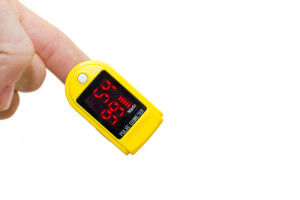
I can’t breathe! I feel short of breath all of the time. We hear these statements every day at PAH specialty centers. We take vital signs of blood pressure, heart rate, respiration rate and oxygen saturation and patients are always surprised if their oxygen saturations are within normal limits. Read below to learn more.
What is oxygen saturation?
Oxygen saturation measures the percentage of hemoglobin in your blood that is carrying oxygen. Many physician offices measure this by putting a pulse oximeter, commonly called a pulse ox, on a patient’s finger. There are two numbers on the pulse ox, the pulse and the oxygen saturation. A normal oxygen saturation reading is 95-100%. Physicians aren’t generally concerned about readings above 90%.
3 Factors to consider while measuring oxygen saturation
There are a few factors that may affect the accuracy of a pulse oximeter reading.
1. Nail polish. Because the pulse oximeter relies on light passing through the finger, patients wearing nail polish may not be able to get an accurate reading.
2. Low blood flow. Some diseases such as scleroderma can lead to low blood flow in the fingers. Because the pulse oximeter relies on hemoglobin in the blood it will not give an accurate reading if there is low blood flow.
3. Accurate reading? Most pulse oximeters have an indicator to let the healthcare professional know if it is getting an accurate reading. Some of them have lights that turn green, others have a bar on the side that is illuminated or an illuminated heart. It makes sense that if the pulse ox is not indicating that it is getting an accurate signal, the reading will not be accurate. The health care professional may wait a moment to see if the pulse ox starts to pick up a signal, warm up patients hands and try again or use a different type of pulse ox on the ear.
How can my oxygen saturation be normal when I am short of breath?
Many patients assume that if they are feeling short of breath their oxygen saturations must be low. The oxygen saturation measures the amount of oxygen in the blood not the amount of oxygen rich blood that is being pumped through the body by the heart.
Pulmonary Arterial Hypertension and other advanced lung diseases may cause strain on the heart causing it to pump less efficiently. An inefficient heart has a lower cardiac output, a lower amount of blood being sent out of the heart to the rest of the body with each beat. This leads to the feeling of shortness of breath.
Adding supplemental oxygen to a patient with normal oxygen saturations will generally not improve their shortness of breath. Treatments for this shortness of breath with normal oxygen saturations should be focused on treating the underlying disease causing the decreased cardiac output.
